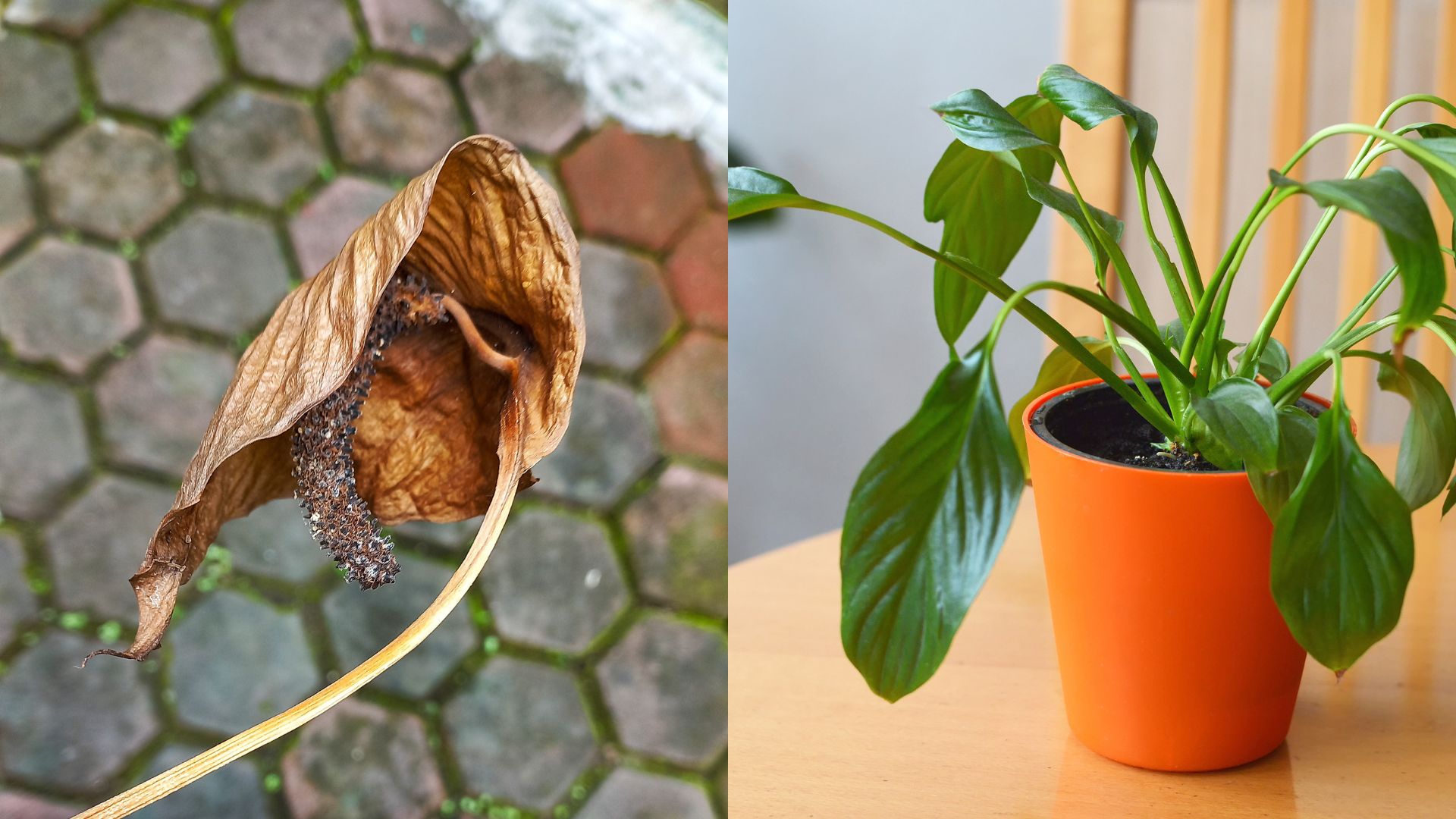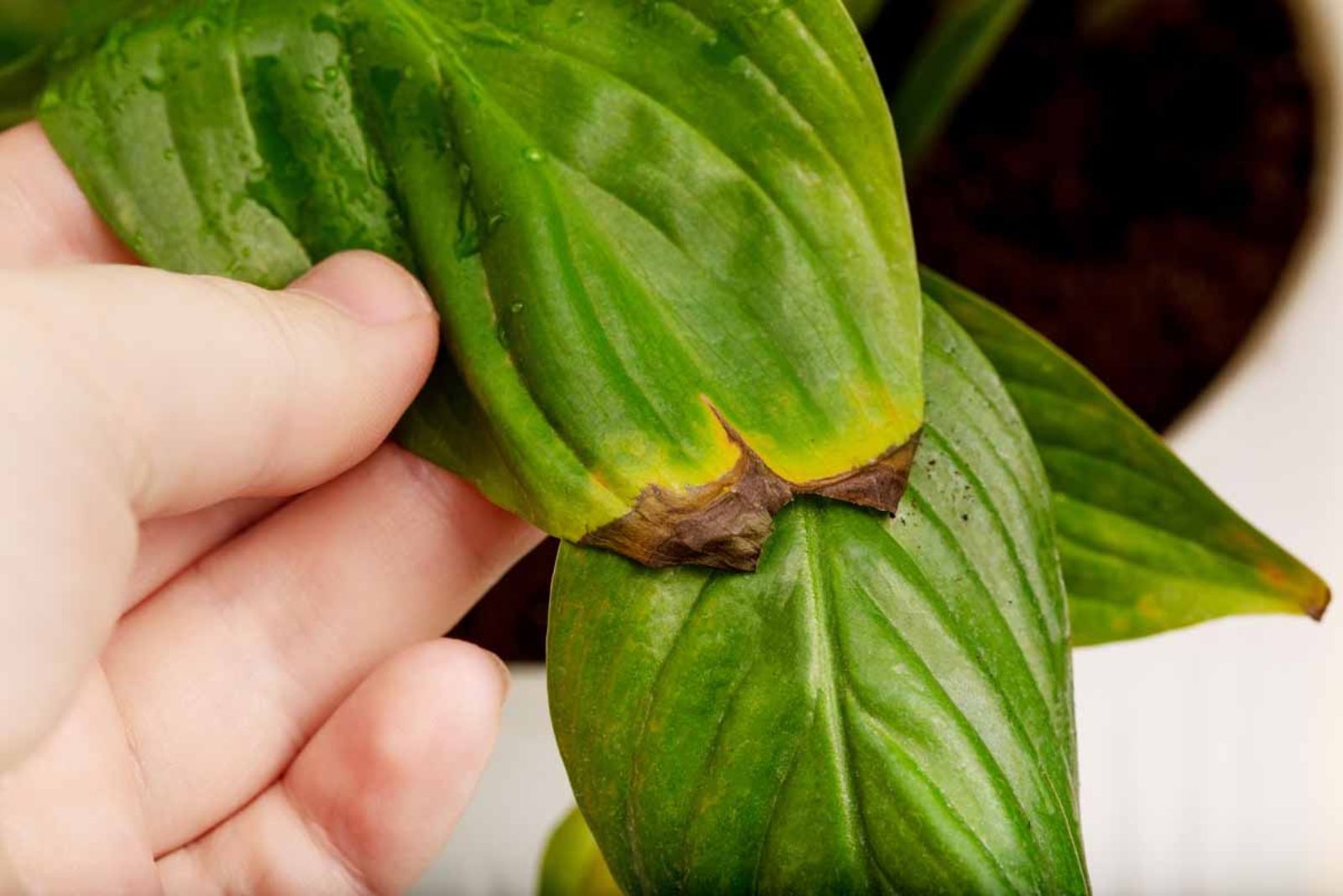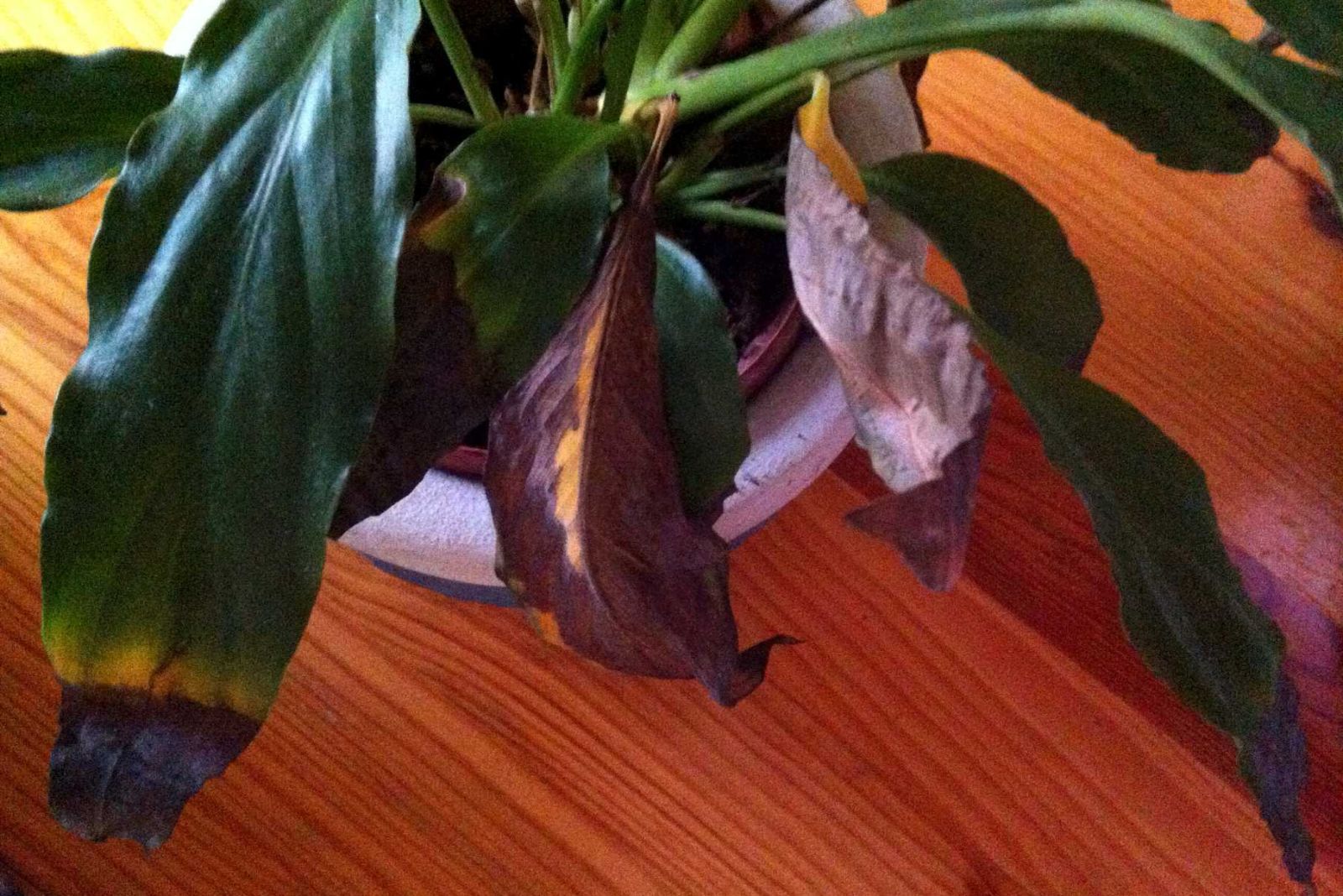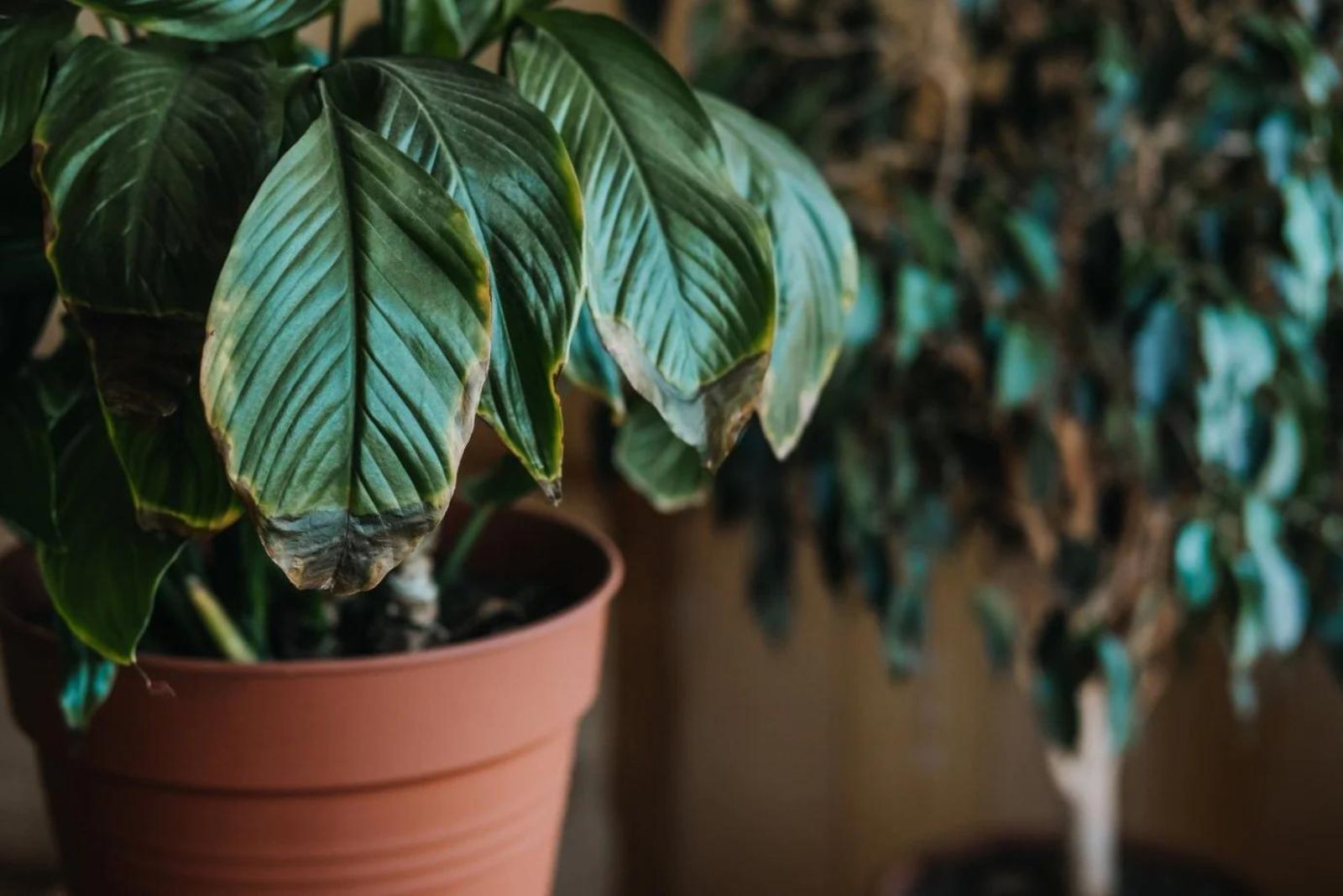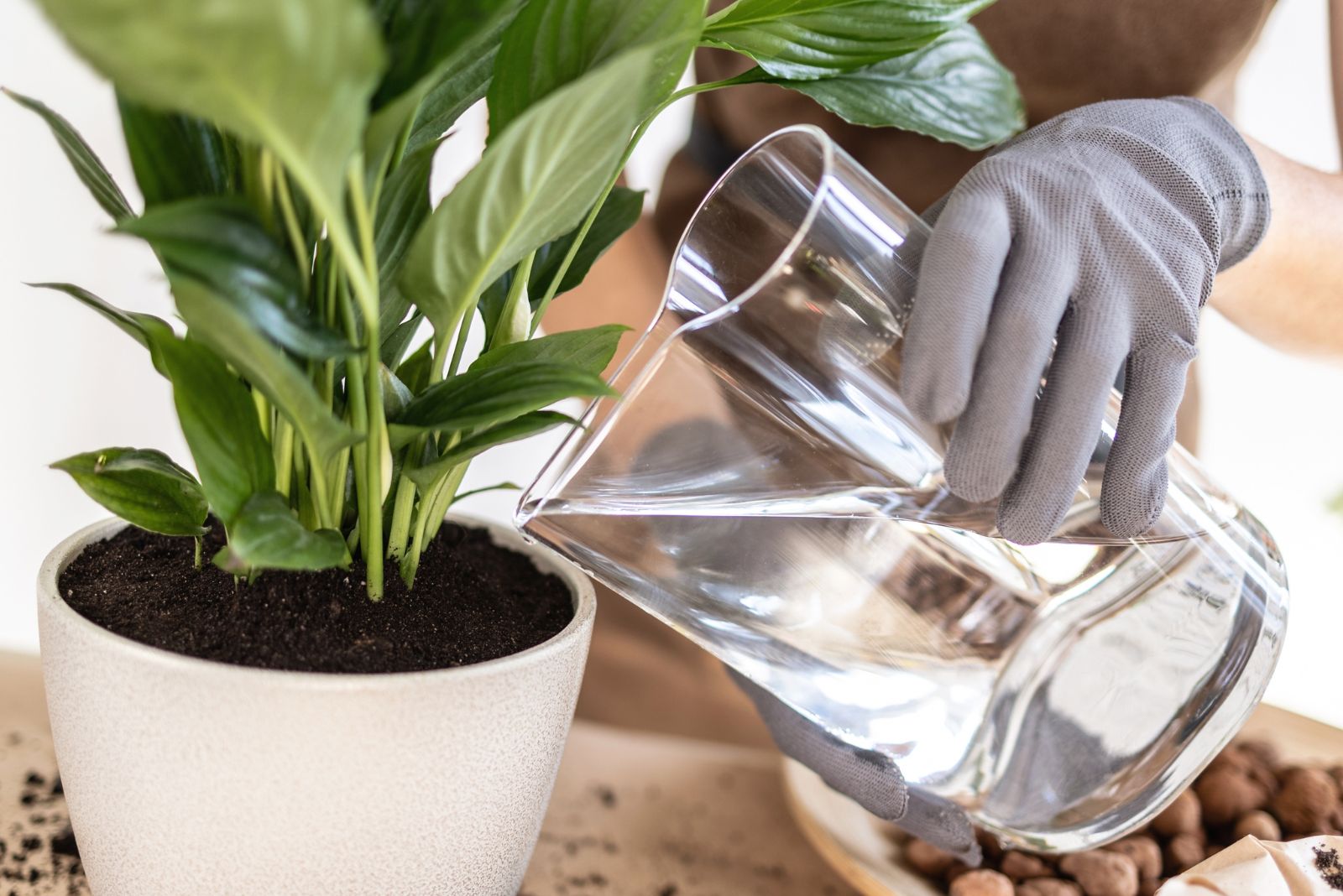The Peace lily is a must-have plant for indoor settings because of its captivating creamy white flowers and low care requirements.
But there isn’t a plant that doesn’t face any problems at all, and the Peace lily isn’t an exception. Browning is actually a common issue in this plant and it’s essential to quickly identify the cause and then start saving your plant.
In this article, I’ll show you the main reasons why Peace lily leaves turn brown and how to fix it. You’ll also see some top-notch Peace lily care tips, so stay tuned!
Let’s get started!
1. Your Peace Lily Is Overwatered
If you notice brown leaves on your Peace lily, the first thing you should do is check the soil moisture content. Watering is one of the hardest aspects of plant care to figure out, especially when it comes to Spathiphyllum plants.
Browning foliage is most frequently caused by overwatering. Peace lily plants are native to tropical regions and the key to healthy growth is consistently moist soil.
Growers often don’t know the difference between moist and waterlogged and that’s when all the issues start. If the Peace lily roots are standing in water for a long time, they’ll drown and stop supplying other plant parts with water and nutrients.
An overwatered Peace lily may end up with root rot disease and wilting, yellowing, and stunted growth will follow browning.
How To Treat An Overwatered Peace Lily
The success rate of recovery for your overwatered Spathiphyllum mainly depends on the severity of the damage.
The first step is to allow the Peace lily soil to dry out entirely by putting it in bright indirect light for a few days.
Never put your Peace lily plant in full sun to increase the drying rate because it will cause additional issues.
If the damage is severe and all plant parts are affected, it would be best if you repotted your Peace lily and removed all the infected parts.
2. Or Underwatered
Another common irrigation issue is underwatering, which can cause browning in your Peace lily.
However, in this case, your plant will first display yellow foliage and it will eventually turn brown and die back.
Wilting can occur in both overwatered and underwatered plants but a drooping Peace lily is most likely a consequence of underwatering.
If your Peace lily is underwatered, the soil will be dry and may crumble to the touch.
How To Treat An Underwatered Peace Lily
Underwatering is typically easier to fix than overwatering if you react in time.
You’ll need to water your Peace lily thoroughly and continue irrigating more often until the plant is fully hydrated.
Once the plant shows signs of recovery, you’ll need to continue watering on a recommended schedule. This means that you should allow Peace lily soil to dry out an inch or two below the surface and then add water.
Your Spathiphyllum plant will need more water during the growing season, i.e., spring and summer. Check the soil more often and cut back on irrigating as soon as the fall arrives.
3. Soil Drainage Is Poor
Your watering schedule may be correct but if the soil drainage is poor, you can expect issues to occur. Brown leaves, root rot disease, and lack of blooms can all happen if the soil is inadequate.
Additionally, the problem with drainage can be caused by the type and size of the Peace lily container. If the pot doesn’t have drainage holes or it’s too small for the plant, issues with drainage will happen.
A rootbound Peace lily can’t absorb water properly and it will display discoloration.
How To Fix Drainage
The first step is to choose the correct soil type for your Spathiphyllum plant. A mixture of standard potting mix with peat moss and perlite will ensure all the nutrients and suitable drainage for your Peace lily.
Always make sure to put your Peace lily in a container that has holes in the bottom so that the excess water can drain properly.
If the plant is rootbound, you can repot it into a container that’s approximately 1-2 inches larger than the current one.
4. Water Is Chemically-Treated
Chemically treated tap water poses a threat to the Peace lily’s health. If the foliage has brown tips or edges, the water type may be the culprit.
Leaves can also be crispy but the problem can be treated by changing the water type you use.
Which Water Type Is The Best For Peace Lilies?
These plants are indeed sensitive to tap water but that doesn’t mean you can’t use this type of water at all.
All you need to do is pour some water into a jar or bucket and leave it to sit overnight for the chemicals to evaporate.
Distilled water is another great option or you could try harvesting rainwater, which is proven to be the best choice for plants.
5. Temperatures Are Extreme
The majority of houseplants are sensitive to temperature fluctuations and the Peace lily is probably on the top of the list.
Sudden temperature changes and cold drafts often lead to browning leaves and your plant will need a new spot.
What Is The Ideal Temperature Range For Peace Lilies?
Spathiphyllum plants flourish at temperatures ranging between 65 and 75 degrees Fahrenheit.
You should select a spot for your Peace lily that’s not too close to doors or heating sources. If you put it on a windowsill, make sure the leaves don’t touch the window glass.
The daytime temperature in the room where you keep this plant should never go below 60 degrees Fahrenheit.
6. Humidity Is Too Low
Tropical plants, such as the Peace lily, are used to high humidity found in rainforests. Average indoor humidity is way lower, which can be pretty dangerous for these plants.
Some plants may adapt well but if they display brown leaf tips and edges, you’ll need to increase humidity around them.
How To Increase Humidity
There are several ways to increase humidity around your Peace lilies. If humidity levels aren’t too low, you can mist the plant foliage a few times a week.
You can also put your Peace lilies near other plants from your collection and in that way create a microclimate and raise humidity.
Pebble trays are often used for increasing humidity, but if it’s too low then a humidifier will do the best job.
7. You Fertilize Incorrectly
Overfertilization is one of the causes of browning or even blackening of Peace lily leaves.
Two factors contribute to overfeeding: fertilizing too frequently and not diluting fertilizers according to the instructions.
In some cases, lack of nitrogen may be the cause of brown leaves in your Spathiphyllum plants. They’ll first turn yellow, then brown, and eventually die back.
How To Fertilize Peace Lilies
For healthy and happy Peace lilies, feed them every six weeks but only during the growing season.
The best type of fertilizer for Spathiphyllum plants is balanced with an NPK ratio of 20-20-20.
Start applying fertilizer in late winter and make sure to dilute it to half strength before usage.
8. It’s Exposed To Too Much Sun
If you need a plant for an office with no windows, a Peace lily will do the perfect job. This means that these plants do well in lower light levels.
Placing Peace lilies in direct sun may result in leaf discoloration and scorching.
What Is The Perfect Light Level For Peace Lilies?
Spathiphyllum species flourish in bright indirect light. You should opt for a spot near an east- or west-facing window.
Windows with southern exposure receive too much direct sunlight whereas north-facing windows don’t have enough light for your Peace lilies.
Should You Remove Brown Leaves On Your Peace Lily Plant?
Your Peace lily will most likely first display browning on the leaf tips and along the edges. You can trim these sections using a sharp and clean pair of scissors but make sure to make angled cuts to retain the natural shape of the leaves.
It would be best if you removed the entire leaves if their edges have turned brown completely. Also, cut off juvenile brown leaves and some older discolored leaves, if any.
However, make sure you don’t prune more than ⅓ of your Spathiphyllum plant.
Quick Peace Lily Watering Tips
Since the frequency and technique for watering Peace lilies cause most of the issues in these plants, here are some tips that can help you.
• Always check soil moisture content before watering your Peace lily. Put your finger in the soil and if the soil is dry, proceed with watering. A moisture meter can also help you in determining soil moisture.
• Use rainwater, distilled water, or tap water that was left to sit overnight.
• Put your Spathiphyllum in a sink or bucket and pour water until it starts coming through the drainage holes and leave it to drain well.
• If you notice sudden drooping or some yellowing of the leaves, add water immediately and your Peace lily will recover in no time.
Peace lilies are amazing plants and look stunning in houseplant collections. If you have issues with brown leaves, follow our guidelines and your lovely plant will be back on track in no time!

